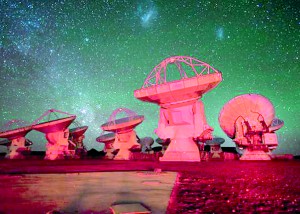Sunday Times 2
The £1billion ‘time machine’
View(s):World’s largest telescope will finally be turned on in the hope that it will finally reveal mysteries of the universe
By Fiona Macrae
It looks like it belongs in a science fiction film but this ‘time machine’ could provide us with the facts about where we came from.
To be switched on, the Atacama Large Millimeter Array, or ALMA, is the world’s most powerful telescope.
It is also the highest on the planet and, at almost £1billion, the most expensive of its kind.

Some of the ALMA antennae bathed in red light. In the background there is the southern Milky Way on the left and the Magellanic Clouds at the top
It is hoped it will allow astronomers to learn about our origins by peering back to almost the first moments after the universe was formed.
Built deep in the Chilean desert, in one of the driest places on Earth, ALMA is at an altitude of 16,400ft – roughly half the cruising height of a jumbo jet and almost four times the height of Ben Nevis.
Rather than one single telescope, it is made up of 66 giant antennae which gather faint radio waves from space for processing by a supercomputer.
Costing £950million to build, including around £65million from the UK, and billed as being ‘in search of our cosmic origins’, it is hoped it will provide answers as to where the stars, the planets, and, ultimately where we came from.
By collecting radio waves rather than optical light, ALMA can look through the dense dust clouds of deep space.
This will give astronomers a glimpse of galaxies from just after the Big Bang.
It can also look at how individual stars and planets are formed. This could shine a light on our creation as it is believed the elements spewed out by dying stars went on the seed the sun, the planets and, eventually, humans.
It will also tell us more about where life came from by finding traces of compounds from water to chemicals similar those in DNA.
Brian Ellison, of the Science and Technology Facilities Council and ALMA’s UK project manager, said: ‘It is said we are all made of stardust.
‘ALMA will answer certain questions about where we came from.’
The telescope, which was part-built by British companies, has yet to run at full power.
But when all the dishes are operating in unison , the resulting images should be ten times sharper than those of the Hubble space telescope.
To get such pictures from a single land-based radio telescope, it would have to be ten miles wide.
The Chilean desert was chosen because it is one of the few places in the world where it is still possible to find a high, dry location unaffected by pollution from artificial light.
Dryness is particularly important as moisture in the air absorbs the radio waves the dishes are trying to capture.
But while the site promises good scientific results, the setting on the edge of the Andes poses difficulties for those who work there.
To keep altitude sickness at bay, as much work as possible is done at a control centre on lower ground.
Visits to the telescope site are kept as short as possible and workers carry oxygen tanks.
A spokesman for the European Southern Observatory, which co-ordinates the European investment, said: ‘ALMA contributes profoundly to the satisfaction of curiosity, not just of the professional researcher, but of the child who looks at the sky full of stars and wonders what they are and what part of the universe we occupy.’
© Daily Mail, London
Follow @timesonlinelk
comments powered by Disqus



















